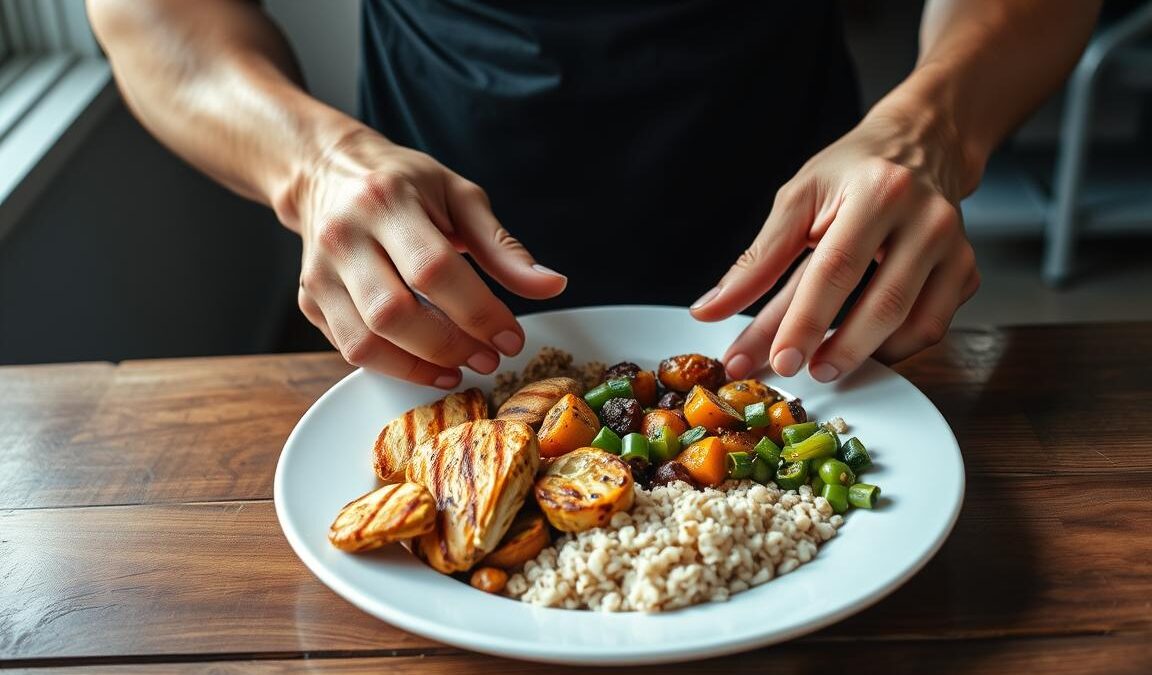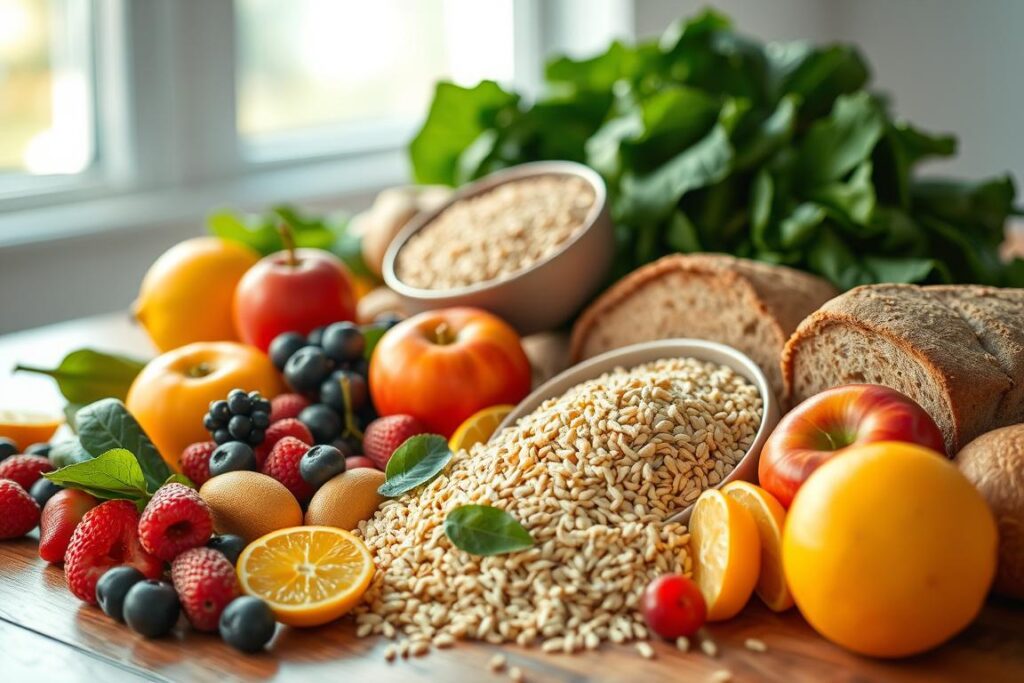
Mindful Eating Habits That Support Muscle Gain and Fat Loss
mindful eating habits for muscle gain can change how your body responds to training and daily life. Start with clear, simple targets: aim for 1.4–2.0 g/kg of protein per day, spread across meals, and include 15–25 g within two hours after a workout to support recovery.
Pair consistent resistance sessions with enough calories—try a starting point near 16–18× your body weight in pounds and track progress over 1–2 weeks. Choose real, convenient protein sources like eggs, Greek yogurt, chicken, tuna, lentils, and protein shakes to hit targets when life is busy.
Practical cues help you act: pause before a meal, check hunger, set a protein goal, then eat with intention. That simple habit ties your food to training, boosts recovery, and keeps fat-loss goals realistic while preserving strength and health.
Key Takeaways
- Use 1.4–2.0 g/kg protein per day and space it across meals.
- Consume 15–25 g protein within two hours post-workout to aid repair.
- Start calories near 16–18× body weight (lbs) and monitor 1–2 weeks.
- Pick convenient protein foods: eggs, Greek yogurt, chicken, tuna, lentils.
- Simple pre-meal cues keep eating intentional and aligned with training.
Set your goal and align your plate with training for results that last
Set a clear goal, then build each plate to support that day’s training and recovery. Know if you are gaining muscle, losing fat, or recomposing and let that guide portions and timing.
Match nutrition with resistance training to drive muscle growth and recovery
If you lift heavy, plan more protein and carbs to meet your body’s needs. Anchor protein at each meal and time carbs around hard sessions to support strength and muscle growth.
Tune into hunger and fullness cues without distraction to prevent overeating
Use a 10-second pause before you eat to set intention. Eat without screens so you can notice real hunger and fullness and make better food choices later in the day.
Use intention setting before meals to support energy, performance, and health
Ask: what did I train and what energy do I need now? Plate a protein first, add carbs or fats based on session demand, and keep portions reasonable. Small, repeatable actions beat perfect plans; check in with your body each day and adjust as the process unfolds.
- Match meals to the training of the day.
- Pause before you eat and set intention.
- Keep the environment simple: plate veggies first and stash extras.
How to practice mindful eating habits for muscle gain
Make protein the first pick on your plate, and build the rest of the meal around it. This simple shift makes hitting daily protein targets easier and improves recovery after training.
Build meals around a protein first, then add smart carbs and fats
Start each meal with protein: Greek yogurt, eggs, chicken, tuna, tofu, or lentils. Add carbs and fats to match your energy needs and session intensity.
Eat every three to four hours and pace your meals to notice satiety
Space your eating roughly every three to four hours to keep protein available throughout day. This cadence supports synthesis and helps avoid late-night overeating.
Check in mid-meal: hunger/fullness cues and portion choices in real time
Pause midway and rate hunger on a 1–10 scale. If you’re a 6 or lower, give yourself a moment before more food. Adjust portions instead of finishing by habit.

Keep a simple food journal to spot patterns and improve consistency
Track basic details for one week: what you ate, rough portions, timing, training, and how you felt. Circle patterns that helped you stay consistent.
- Quick builder: protein + produce + starch + flavor.
- Go-to options: chia pudding, bean soup, turkey or chickpea wraps, protein energy balls, yogurt parfaits.
- Front-load protein at breakfast and lunch (25–40 g) if you under-eat earlier in the day.
| Option | Serving | Protein (g) | When to use |
|---|---|---|---|
| Greek yogurt parfait | 1 cup + fruit | 20–24 | Breakfast or snack |
| Bean or lentil soup | 1.5 cups | 15–18 | Lunch or light dinner |
| Chicken/turkey wrap | 1 wrap | 25–30 | Post-workout lunch |
| Protein energy balls | 2–3 balls | 8–12 | On-the-go snack |
Protein, amino acids, and timing: what to eat and when for muscle protein synthesis
Timing and quality of protein shape how well your body rebuilds after training. Aim for the ISSN guideline of 1.4–2.0 g/kg body weight per day and spread that intake across the day.
Research supports 15–25 g of protein within two hours after a workout to kick-start repair. Muscle protein synthesis continues over 24 hours, so the post-session dose is a jump-start, not the whole story.
What to pick and when
Focus on leucine-rich whole foods: eggs, chicken, dairy, soy, beans, and lentils. Whole eggs often outperform egg whites alone for post-exercise protein synthesis, so include the yolk when calories allow.
Mix whole-food staples with supplements where convenient: Greek yogurt at lunch, cottage cheese at night, tofu or chicken at dinner, and whey or a protein shake on the go.
- Daily target: 1.4–2.0 g/kg per day, adjusted by training load and recovery.
- Per meal: 25–40 g common for most adults; snacks 15–25 g to maintain amino availability.
- Practical tip: Start in the mid-range, monitor recovery, and tweak intake weekly.
| Timing | Protein dose | Typical choices |
|---|---|---|
| Post-workout (0–2 hrs) | 15–25 g | Whey shake, chicken wrap, Greek yogurt |
| Per meal (3–4 hr spacing) | 25–40 g | Eggs, tofu, cottage cheese, lean poultry |
| Night | ~20 g | Cottage cheese, casein, Greek yogurt |
Carbohydrates, healthy fats, and calories: fueling strength and supporting hormones
Carbs are your training fuel—place them before and after hard sessions to keep energy high and recovery fast.
Use carbohydrates around training: a small, carb-focused snack 30–90 minutes before workouts and a fuller carb serving after helps sustain performance and speeds glycogen replenishment.
Keep everyday sources simple and reliable: rice, oats, potatoes, fruit, beans, and whole-grain bread. Pick what you enjoy and tolerate—consistency beats perfection.

Fats that support hormones and satiety
Include healthy fats daily to support hormones and immune health. Cook with olive oil, add nuts and seeds, and rotate fatty fish like salmon or sardines a few times weekly.
If appetite is low, add a spoon of oil, a handful of nuts, or an extra serving of avocado to boost intake without bulky meals.
How much to eat and simple adjustment rules
Start calories at 16–18× your body weight in pounds and watch weight and training for 1–2 weeks. If weight and performance stall, add 100–200 calories and reassess.
- Increase carbs first if training performance dips.
- Add calorie-dense fats if you struggle to eat enough.
- Balance plates: chicken or tofu with rice and veggies; oats and yogurt for breakfast; bean lunches for steady fuel.
| Goal | Starting plan | Quick adjustment |
|---|---|---|
| Maintain energy & performance | Carbs around workouts; daily mixed carbs | +100 kcal from carbs if energy dips |
| Increase weight/building | Start 16–18× body weight (lbs) | +100–200 kcal/week until weight rises |
| Low appetite | Add healthy oil, nuts, fatty fish | Swap water for calorie-dense snacks |
Track simple markers: gym performance, sleep, mood, and appetite. If they improve, your diet and nutrition choices are working.
If you feel unusually drained while bulking, read this short guide on always tired when bulking.
Put it into practice: day-of-eating templates, easy swaps, and prep tips
Build a day of food that’s fast to assemble and focused on steady protein and carbohydrates. Use templates that free up decision time and keep recovery and strength on track. Below are ready-to-use options you can follow on training days or busy weekdays.
A balanced training day
Breakfast: eggs with fruit and toast, or chia pudding made with milk or soy milk. Both supply protein and carbohydrates to start the day.
Lunch: hearty bean or lentil soup plus whole-grain crackers and a side of Greek yogurt for an extra protein boost.
Dinner: rotate chicken, turkey, fish, or tofu with rice or potatoes and a generous portion of vegetables. Finish with cottage cheese or yogurt if you need more protein.
Quick snacks and prep tips
- Snacks: protein energy balls, Greek yogurt bark, or a protein shake with a banana to bridge recovery windows.
- Meal prep: bulk-cook chicken, rice, and vegetables on Sunday; portion into containers to grab all week.
- Stock staples: Greek yogurt, cottage cheese, canned beans, and tuna for fast, reliable foods when plans change.
- Easy swaps: tofu for chicken, quinoa for rice, olive-oil roasted vegetables, or soy milk in smoothies to increase protein.
- Two-protein safety net: include protein at the meal and in a snack on training days so you hit targets without stress.
| Time | Example | Why it works |
|---|---|---|
| Morning | Eggs or chia pudding | Fast protein + carbs to fuel training |
| Midday | Bean soup + Greek yogurt | Sustained protein and carbohydrates |
| Evening | Chicken or tofu + rice | Recovery-focused protein and starch |
Keep templates simple and repeatable. Small wins add up: one planned meal at a time keeps your goals within reach.
Conclusion
Close the loop by turning small daily choices into steady progress toward strength and growth.
Keep your focus simple: align meals with training, center protein, and use short checks to guide portions and energy. Track weight, workout performance, and appetite over 1–2 weeks and adjust calories from the 16–18× body weight starting point.
Build plates from reliable foods like chicken, eggs, beans, yogurt, and tofu. Hit protein across the day and include a post-workout dose so amino acids support muscle protein synthesis and recovery.
Sleep, stress control, and planned rest amplify gains. Pick one habit to improve each week, stay patient, and let consistent choices do the work in this long-term process.


